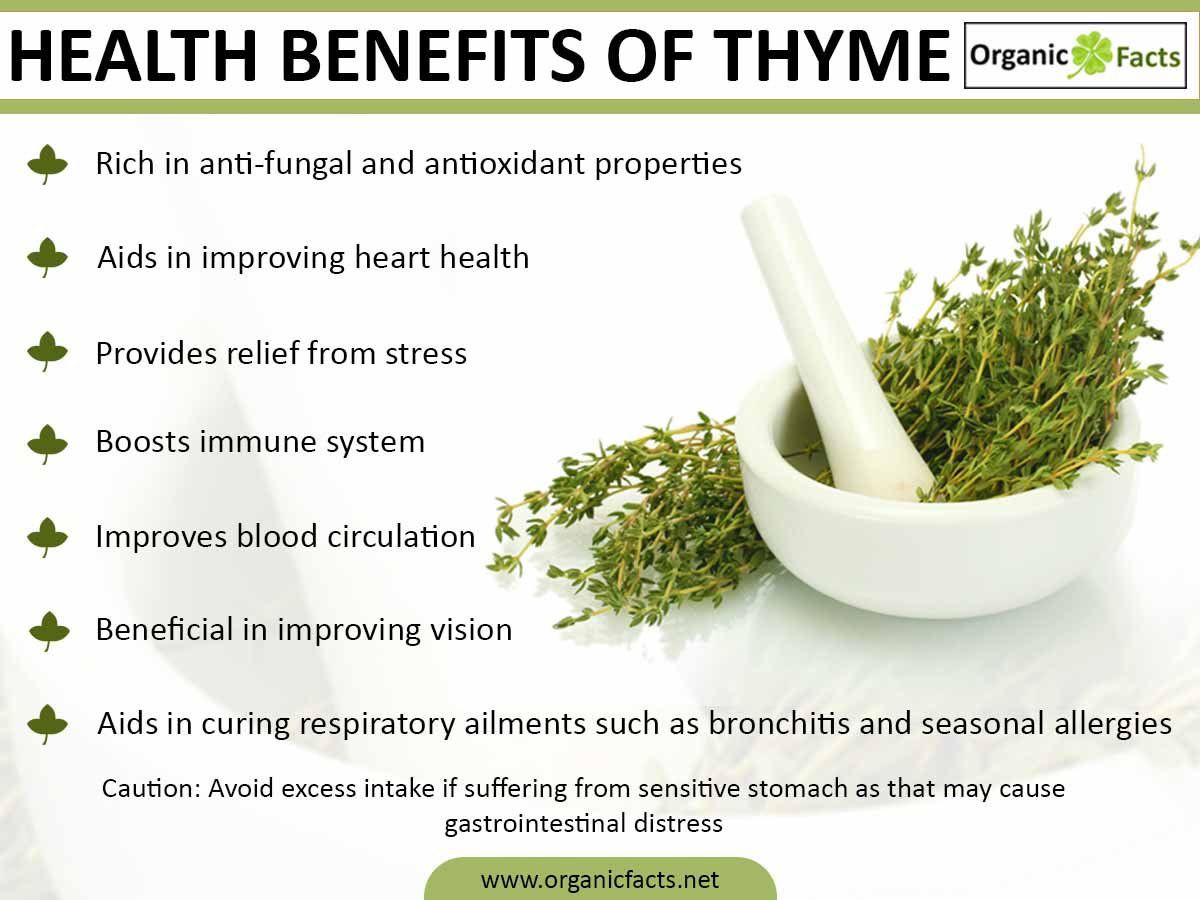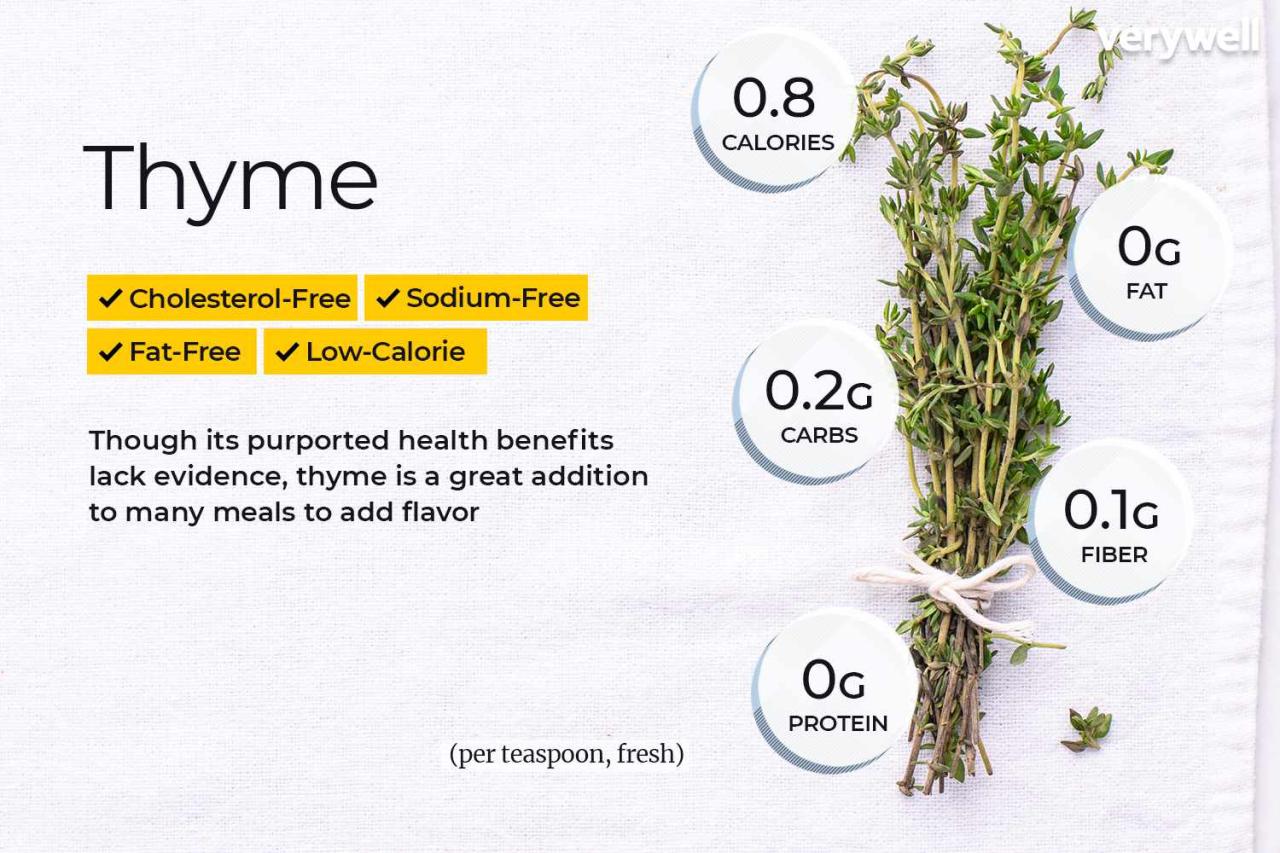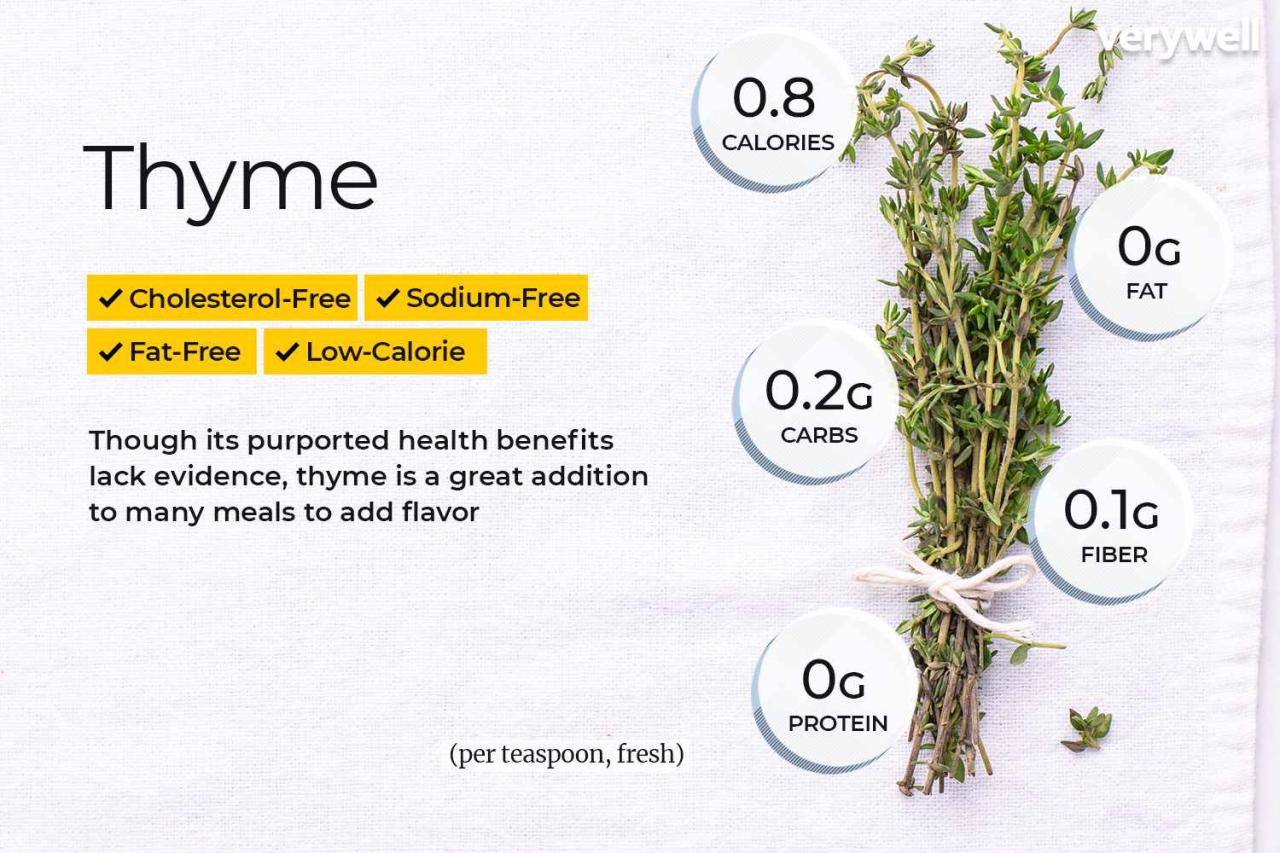Thyme Piece: A Simple Herb with Incredible Flavor Benefits, this unassuming herb has captivated palates and cultures for centuries. From its ancient origins in the Mediterranean to its ubiquitous presence in modern kitchens worldwide, thyme’s versatility and flavor have made it a culinary staple.
Beyond its deliciousness, thyme boasts a remarkable array of health benefits, adding another layer to its appeal.
This article delves into the fascinating world of thyme, exploring its history, culinary applications, flavor profile, nutritional value, and medicinal properties. We’ll also provide practical tips on growing, harvesting, and preserving this aromatic herb, allowing you to enjoy its benefits year-round.
Introduction to Thyme
Thyme, a member of the mint family, is an aromatic herb renowned for its culinary and medicinal properties. Its history dates back centuries, with evidence of its use in ancient Egypt, Greece, and Rome. Thyme’s name is derived from the Greek word “thymos,” meaning “courage,” reflecting its historical use as a symbol of strength and bravery.
Thyme’s Botanical Classification and History
Thyme is classified botanically asThymus vulgaris*, belonging to the Lamiaceae family. It is a perennial herb, meaning it lives for more than two years, and is native to the Mediterranean region. Its cultivation spread throughout Europe and Asia, and eventually, to other parts of the world.Thyme has a rich history, with records of its use dating back to ancient civilizations.
The Egyptians used thyme for embalming, while the Greeks believed it had medicinal properties and used it to treat a range of ailments. The Romans used thyme in cooking and for its antiseptic qualities.
Types of Thyme
There are numerous varieties of thyme, each with unique characteristics and flavor profiles. Here are some common types:
- Common Thyme (Thymus vulgaris): The most common type, known for its strong, pungent flavor. It is often used in Mediterranean cuisine.
- Lemon Thyme (Thymus citriodorus): This variety has a distinct citrusy aroma and flavor, making it a popular addition to seafood dishes and salads.
- Creeping Thyme (Thymus serpyllum): This type is a low-growing groundcover with a milder flavor. It is often used in landscaping and as a culinary herb.
- Caraway Thyme (Thymus herba-barona): This thyme variety has a unique flavor reminiscent of caraway seeds. It is commonly used in savory dishes and soups.
- Silver Thyme (Thymus vulgaris ‘Silver Queen’): This type has silvery-green foliage and a slightly milder flavor than common thyme. It is often used for its ornamental value.
Culinary Uses of Thyme
Thyme’s versatility extends beyond its fragrant aroma, making it a staple in diverse cuisines worldwide. Its flavor profile, ranging from subtly sweet to intensely herbaceous, adds depth and complexity to dishes. From traditional Mediterranean recipes to modern culinary creations, thyme’s presence elevates the taste experience.
Thyme’s Global Culinary Reach
Thyme’s use in culinary traditions across the globe highlights its adaptability and widespread appeal. In Mediterranean cuisine, thyme is an essential ingredient in classic dishes like roasted lamb, chicken, and fish. It adds a distinct earthy flavor to stews, soups, and sauces, complementing the region’s rich culinary heritage.
In French cuisine, thyme finds its place in hearty stews, savory sauces, and aromatic herb blends. It’s a key ingredient in the classic Provençal dish, “herbes de Provence,” a blend of dried herbs including thyme, rosemary, oregano, and marjoram. Moving east, thyme plays a vital role in Middle Eastern and North African cuisine.
It adds a distinctive flavor to tagines, couscous dishes, and spiced meat preparations. Thyme’s earthy notes complement the rich spices and flavors of these regions, enhancing their culinary traditions.
While thyme is known for its culinary versatility, adding a burst of flavor to countless dishes, the world of herbal medicine offers a treasure trove of lesser-known botanicals. One such hidden gem is the Biota herb, explored in depth in this article, Biota Herb: The Hidden Gem of Herbal Medicine.
Like thyme, biota holds medicinal properties, highlighting the diverse benefits that nature offers, from the familiar to the yet-to-be-discovered.
Thyme Pairings and Flavor Combinations
Thyme’s versatility allows it to be paired with a wide range of ingredients, creating a symphony of flavors. The following table showcases some common thyme pairings with various dishes:
Dish |
Thyme Pairing |
Flavor Profile |
|---|---|---|
Roasted Chicken |
Lemon, Garlic, Rosemary |
Herbaceous, Citrusy, Earthy |
Grilled Salmon |
Dill, Capers, Olive Oil |
Fresh, Salty, Aromatic |
Tomato Soup |
Basil, Garlic, Onion |
Savory, Earthy, Sweet |
Mushroom Risotto |
Parmesan Cheese, White Wine |
Creamy, Savory, Umami |
Lamb Stew |
Carrots, Celery, Onions |
Rich, Hearty, Aromatic |
Popular Thyme-Based Recipes
Thyme’s culinary prowess is evident in numerous popular recipes, each showcasing its unique flavor contribution.
- Chicken with Thyme and Lemon:This classic dish features chicken roasted with thyme, lemon, and garlic, creating a fragrant and flavorful meal.
- Herb-Crusted Salmon:A simple yet elegant dish, herb-crusted salmon combines thyme, rosemary, and parsley for a flavorful and aromatic crust.
- Thyme and Garlic Bread:A popular side dish, thyme and garlic bread is a simple yet satisfying combination of garlic, thyme, and butter, creating a flavorful and aromatic accompaniment to various meals.
- Roasted Vegetables with Thyme:Thyme’s earthy flavor complements roasted vegetables, adding depth and complexity to their natural sweetness.
- Thyme-Infused Oil:Infused with thyme, olive oil takes on a rich, aromatic flavor, perfect for drizzling over salads, pasta dishes, or grilled meats.
Flavor Profile and Sensory Attributes

Thyme’s flavor profile is characterized by its distinct, earthy, and slightly pungent notes. Its aroma and taste are complex, offering a unique sensory experience that adds depth and richness to culinary creations.
Fresh Thyme vs. Dried Thyme
The taste of fresh thyme is brighter and more herbaceous, with a pronounced citrusy undertone. It’s more delicate and less intense than dried thyme. In contrast, dried thyme has a more concentrated and robust flavor, with a slightly bitter edge.
The drying process intensifies the flavor, making a smaller amount of dried thyme go a long way.
Nutritional Value and Health Benefits
Thyme is not only a flavorful culinary herb but also a nutritional powerhouse, packed with vitamins, minerals, and antioxidants. These components contribute to a variety of health benefits, making thyme a valuable addition to a healthy diet.
Nutritional Composition
Thyme is a rich source of essential nutrients, including:
- Vitamins:Vitamin C, Vitamin A, Vitamin K, Vitamin E, and B vitamins (including thiamin, riboflavin, niacin, and folate).
- Minerals:Iron, calcium, magnesium, potassium, manganese, and zinc.
- Antioxidants:Thyme is particularly high in antioxidants, such as flavonoids, phenolic acids, and rosmarinic acid, which help protect cells from damage caused by free radicals.
Potential Health Benefits of Thyme
Scientific research has revealed several potential health benefits associated with thyme consumption:
- Anti-inflammatory properties:Thyme’s antioxidants, particularly rosmarinic acid, have demonstrated potent anti-inflammatory effects in studies. These properties may help reduce inflammation throughout the body, potentially benefiting conditions like arthritis and inflammatory bowel disease.
- Antimicrobial activity:Thyme oil and extracts have shown significant antimicrobial activity against various bacteria, fungi, and viruses. This property makes thyme a potential natural remedy for infections and may contribute to its use in traditional medicine.
- Improved digestive health:Thyme may aid digestion by stimulating the production of digestive enzymes and promoting the growth of beneficial gut bacteria. It has been traditionally used to alleviate symptoms of indigestion, bloating, and gas.
- Cardiovascular health:Thyme may contribute to cardiovascular health by lowering blood pressure and cholesterol levels. Studies suggest that thyme’s antioxidants may help protect against heart disease.
- Immune system support:Thyme’s antioxidants and antimicrobial properties may help boost the immune system and protect against infections. It has been traditionally used as a natural remedy for colds and flu.
Incorporating Thyme into a Healthy Diet and Lifestyle, Thyme Piece: A Simple Herb with Incredible Flavor Benefits
Thyme can be easily incorporated into a healthy diet and lifestyle in various ways:
- Culinary uses:Add fresh or dried thyme to soups, stews, sauces, marinades, roasted vegetables, and meat dishes for flavor and health benefits.
- Infusion:Steep dried thyme in hot water to create a flavorful and aromatic tea. Thyme tea is traditionally used for its soothing and digestive properties.
- Supplements:Thyme supplements are available in various forms, such as capsules, tablets, and extracts. Consult with a healthcare professional before taking any supplements.
- Topical application:Thyme oil can be diluted and applied topically for its antimicrobial and anti-inflammatory properties. It may be helpful for skin conditions like acne and eczema.
Growing and Harvesting Thyme: Thyme Piece: A Simple Herb With Incredible Flavor Benefits
Thyme is a relatively easy herb to grow, thriving in a variety of conditions and offering a rewarding culinary experience. Understanding the optimal growing conditions and proper harvesting techniques can maximize your thyme yield and ensure a rich flavor.
Growing Thyme
- Sunlight:Thyme prefers full sun, receiving at least six hours of direct sunlight daily. This promotes vigorous growth and optimal essential oil production, contributing to its robust flavor.
- Soil:Well-drained soil with a slightly acidic pH (6.0 to 7.0) is ideal. Thyme is tolerant of poor soil conditions but performs best in fertile, sandy loam. Avoid heavy clay soils, which can retain too much moisture and lead to root rot.
- Planting:Thyme can be started from seeds, cuttings, or purchased as seedlings. Direct sowing seeds in the spring after the last frost is recommended. Space plants 12 to 18 inches apart for adequate air circulation and growth. Cuttings should be taken in the spring or summer and rooted in a well-drained potting mix.
Thyme, a culinary staple known for its earthy, pungent aroma, is a herb that can elevate any dish. From hearty stews to delicate salads, thyme adds depth and complexity to flavor profiles. If you’re interested in growing your own thyme, consider a journey from spiky seeds to beautiful blooms, following the expert guidance found in From Spiky Seeds to Beautiful Blooms: A Step-by-Step Guide.
Once you’ve successfully cultivated your own thyme, you’ll be ready to enjoy the fresh, vibrant flavor of this versatile herb in all your culinary creations.
- Watering:Thyme is drought-tolerant and prefers dry soil conditions. Overwatering can lead to root rot. Water deeply but infrequently, allowing the soil to dry out slightly between waterings.
- Fertilizing:Thyme is a light feeder and generally doesn’t require frequent fertilization. A light application of balanced fertilizer in the spring can boost growth.
- Pruning:Regular pruning promotes bushier growth and prevents the plant from becoming leggy. Pinch back the tips of stems regularly to encourage branching and maintain a compact shape.
Harvesting Thyme
- Timing:The best time to harvest thyme is during the peak of its growth season, typically in late spring and early summer. Harvesting before flowering results in the most tender and flavorful leaves.
- Methods:Harvest thyme by snipping off the tips of stems, leaving a few inches of growth on the plant. Avoid harvesting too much at once, allowing the plant to regrow.
Preserving and Storing Thyme
- Fresh Thyme:Store fresh thyme in the refrigerator in a plastic bag or airtight container for up to a week. For longer storage, freeze thyme in a freezer-safe bag or container.
- Dried Thyme:Dry thyme by hanging stems upside down in a cool, dark, and well-ventilated area. Alternatively, use a food dehydrator set to low heat. Once dry, store dried thyme in airtight containers in a cool, dark place.
Thyme in Traditional Medicine and Folklore

Thyme, with its aromatic fragrance and potent medicinal properties, has been a staple in traditional medicine and folklore for centuries. Across cultures, thyme has been revered for its healing abilities and symbolic significance, playing a vital role in various rituals, beliefs, and practices.
Historical Use of Thyme in Traditional Medicine
Thyme’s therapeutic applications have been documented throughout history, with its use spanning various cultures and civilizations.
- Ancient Egypt:Egyptians utilized thyme for its antiseptic and anti-inflammatory properties, incorporating it into balms and ointments to treat wounds and skin infections.
- Ancient Greece:The Greeks, recognizing thyme’s invigorating and stimulating effects, used it to combat fatigue, boost energy, and improve cognitive function. They also employed it to treat respiratory ailments, including coughs and colds.
- Medieval Europe:During the Middle Ages, thyme was widely used in Europe as a remedy for various ailments, including digestive issues, headaches, and even the plague. It was also believed to ward off evil spirits and promote good luck.
- Traditional Chinese Medicine:In traditional Chinese medicine, thyme is valued for its ability to clear heat, relieve pain, and stimulate circulation. It is often used to treat respiratory problems, fever, and digestive disorders.
Cultural Significance of Thyme in Various Traditions
Beyond its medicinal applications, thyme holds deep cultural significance in many societies, often symbolizing courage, strength, and protection.
- Ancient Roman Mythology:Thyme was associated with the god Mars, representing bravery and resilience. Roman soldiers carried thyme amulets into battle, believing it would enhance their courage and protect them from harm.
- Christian Tradition:In Christian folklore, thyme is linked to the Virgin Mary and is said to have sprung from her tears. It is often used in religious ceremonies and symbolizes purity, devotion, and remembrance.
- Folklore and Superstitions:Thyme is believed to possess protective qualities in many cultures. For example, placing thyme under a pillow is said to promote restful sleep and ward off nightmares. Thyme is also associated with good luck, and it is often used in wedding bouquets to symbolize a happy and lasting marriage.
Anecdotes and Stories about Thyme in Folklore and Mythology
- The Legend of the Thyme Fairy:In some European folklore, thyme is said to be guarded by a tiny fairy who grants wishes to those who show respect and kindness to the plant.
- The Story of the Thyme and the Dragon:A Welsh myth tells the story of a brave knight who used thyme to defeat a fearsome dragon. The knight’s sword, infused with thyme, was said to have been strong enough to overcome the dragon’s fiery breath.
- The Use of Thyme in Spells and Incantations:Thyme is frequently used in various magical practices, including spells for protection, healing, and purification. It is believed to amplify the power of incantations and rituals, making them more effective.
Ending Remarks
From adding a burst of flavor to savory dishes to offering potential health advantages, thyme proves itself to be a true culinary and medicinal gem. Whether you’re a seasoned chef or a novice gardener, incorporating thyme into your life can enrich your culinary experiences and contribute to your well-being.
So, let the fragrant aroma of thyme guide you on a journey of flavor and discovery.
Question & Answer Hub
What is the best way to store fresh thyme?
Store fresh thyme in a sealed container in the refrigerator for up to a week. You can also wrap it in a damp paper towel and store it in a plastic bag for longer storage.
Can I use dried thyme instead of fresh thyme?
Yes, you can use dried thyme as a substitute for fresh thyme. However, remember that dried thyme is more concentrated, so use about 1/3 of the amount you would use of fresh thyme.
What are some common thyme varieties?
Some common thyme varieties include common thyme (Thymus vulgaris), lemon thyme, French thyme, and woolly thyme. Each variety has its own unique flavor and aroma.
Is thyme safe for everyone to consume?
While thyme is generally safe for consumption, it’s important to note that some people may be allergic to it. If you have any allergies, consult with your doctor before consuming thyme.
